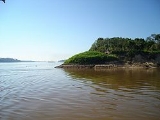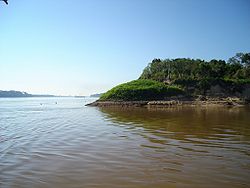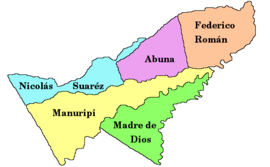
Federico Román Province
Encyclopedia
 |
|
| Río Abuná Abuna River The Abuna River is a river in South America. As a part of the Amazon Basin, it forms part of the border between northern Bolivia and north-western Brazil.... on the right, Río Madeira Madeira River The Madeira River is a major waterway in South America, approximately 3,250 km miles long The Madeira is the biggest tributary of the Amazon... on the left |
|
| Location in Bolivia | |
|---|---|
| General Data | |
| Capital | Nueva Esperanza Nueva Esperanza Nueva Esperanza is a municipality and village in Santiago del Estero in Argentina.... |
| Area Area Area is a quantity that expresses the extent of a two-dimensional surface or shape in the plane. Area can be understood as the amount of material with a given thickness that would be necessary to fashion a model of the shape, or the amount of paint necessary to cover the surface with a single coat... |
13,200 km² |
| Population Population A population is all the organisms that both belong to the same group or species and live in the same geographical area. The area that is used to define a sexual population is such that inter-breeding is possible between any pair within the area and more probable than cross-breeding with individuals... |
2,242 (2001) |
| Density Density The mass density or density of a material is defined as its mass per unit volume. The symbol most often used for density is ρ . In some cases , density is also defined as its weight per unit volume; although, this quantity is more properly called specific weight... |
0.2 inhabitants/km² (2001) |
| ISO 3166-2 ISO 3166-2 ISO 3166-2 is part of the ISO 3166 standard published by the International Organization for Standardization , and defines codes for the names of the principal subdivisions of all countries coded in ISO 3166-1... |
BO.PA.GR |
| Pando Department | |
 |
|
Federico Román (or: General Federico Román) is one of the five provinces of the Bolivia
Bolivia
Bolivia officially known as Plurinational State of Bolivia , is a landlocked country in central South America. It is the poorest country in South America...
n department
Departments of Bolivia
Bolivia is divided into nine departments . Each of the departments is subdivided into provinces , which are further subdivided into municipalities ....
of Pando
Pando Department
Pando is a department of Bolivia, with an area of , adjoining the border with Brazil. Pando has a population 66,689 . Its capital is the city of Cobija....
and is situated in the department's northeastern parts. Its name honours General Federico Román.
Location
Aroma province is located between 09° 41' and 10° 51' SouthLatitude
In geography, the latitude of a location on the Earth is the angular distance of that location south or north of the Equator. The latitude is an angle, and is usually measured in degrees . The equator has a latitude of 0°, the North pole has a latitude of 90° north , and the South pole has a...
and between 65° 17' and 66° 39' West
Longitude
Longitude is a geographic coordinate that specifies the east-west position of a point on the Earth's surface. It is an angular measurement, usually expressed in degrees, minutes and seconds, and denoted by the Greek letter lambda ....
. It extends over 150 km from North to South, and 200 km from West to East.
The province is situated in the Amazon
Amazon Rainforest
The Amazon Rainforest , also known in English as Amazonia or the Amazon Jungle, is a moist broadleaf forest that covers most of the Amazon Basin of South America...
lowlands of Bolivia and borders Abuná Province
Abuná Province
Abuná is one of the five provinces of the Bolivian department of Pando and is situated in the department's northern central parts. It has its name from Río Abuná, the border river to neighbouring Brazil.- Location :...
in the West, Manuripi Province
Manuripi Province
Manuripi is one of the five provinces of Pando Department in Bolivia and is situated in the department's north-western parts. Its name derives from Manuripi River which passes the province from West to East- Location :...
in the Southwest, Beni Department
Beni Department
Beni, sometimes El Beni, is a northeastern department of Bolivia, in the lowlands region of the country. It is the second largest department in the country , covering 213,564 square kilometers , and it was created by supreme decree on November 18, 1842 during the administration of General José...
in the Southeast, and Brazil
Brazil
Brazil , officially the Federative Republic of Brazil , is the largest country in South America. It is the world's fifth largest country, both by geographical area and by population with over 192 million people...
in the East and North.
The border to Beni Department in the South forms Río Beni
Beni River
The Beni River is a river in the north of Bolivia.It rises north of La Paz and flows northeast through the pampas. One of the tributary rivers is Tuichi River in the Madidi National Park. Tuichi River joins the Beni River upstream from the town Rurrenabaque. South of Rurrenabaque, Río Beni runs...
, to neighbouring Brazil Río Madeira
Madeira River
The Madeira River is a major waterway in South America, approximately 3,250 km miles long The Madeira is the biggest tributary of the Amazon...
in the East and Río Abuná
Abuna River
The Abuna River is a river in South America. As a part of the Amazon Basin, it forms part of the border between northern Bolivia and north-western Brazil....
in the North.
Population
The population of Federico Román Province has increased by more than 100 % over the recent two decades:- 1992: 1,516 inhabitants (censusCensusA census is the procedure of systematically acquiring and recording information about the members of a given population. It is a regularly occurring and official count of a particular population. The term is used mostly in connection with national population and housing censuses; other common...
) - 2001: 2,242 inhabitants (censusCensusA census is the procedure of systematically acquiring and recording information about the members of a given population. It is a regularly occurring and official count of a particular population. The term is used mostly in connection with national population and housing censuses; other common...
) - 2005: 2,912 inhabitants (est.)
- 2010: 3,600 inhabitants (est.)
39.6 % of the population are younger than 15 years old. (1992)
87.9 % of the population speak Spanish
Spanish language
Spanish , also known as Castilian , is a Romance language in the Ibero-Romance group that evolved from several languages and dialects in central-northern Iberia around the 9th century and gradually spread with the expansion of the Kingdom of Castile into central and southern Iberia during the...
, 3.1 % speak Quechua, 1.2 % Aymara
Aymara language
Aymara is an Aymaran language spoken by the Aymara people of the Andes. It is one of only a handful of Native American languages with over three million speakers. Aymara, along with Quechua and Spanish, is an official language of Peru and Bolivia...
, and 26.5 speak foreign languages (mainly Portuguese
Portuguese language
Portuguese is a Romance language that arose in the medieval Kingdom of Galicia, nowadays Galicia and Northern Portugal. The southern part of the Kingdom of Galicia became independent as the County of Portugal in 1095...
, due to the nearness to Brazil) . (1992)
The literacy rate
Literacy
Literacy has traditionally been described as the ability to read for knowledge, write coherently and think critically about printed material.Literacy represents the lifelong, intellectual process of gaining meaning from print...
of the province's population is 72.6 %. (1992)
83.1 % of the population have no access to electricity, 59.1 % have no sanitary facilities. (1992)
83.1 % of the population are Catholics, 15.2 % are Protestants. (1992)
Division
The province comprises three municipiosMunicipalities of Bolivia
Municipalities in Bolivia are administrative divisions of the entire national territory governed by local elections. Municipalities are the third level of administrative divisions, below departments and provinces. Some of the provinces consist of only one municipality...
:
- Nueva Esperanza Municipality - 970 Einw. (2005)Instituto Nacional de Estadística
- Santos Mercado Municipality - 771 Einw. (2005)
- Villa Nueva Municipality - 1,171 Einw. (2005)

